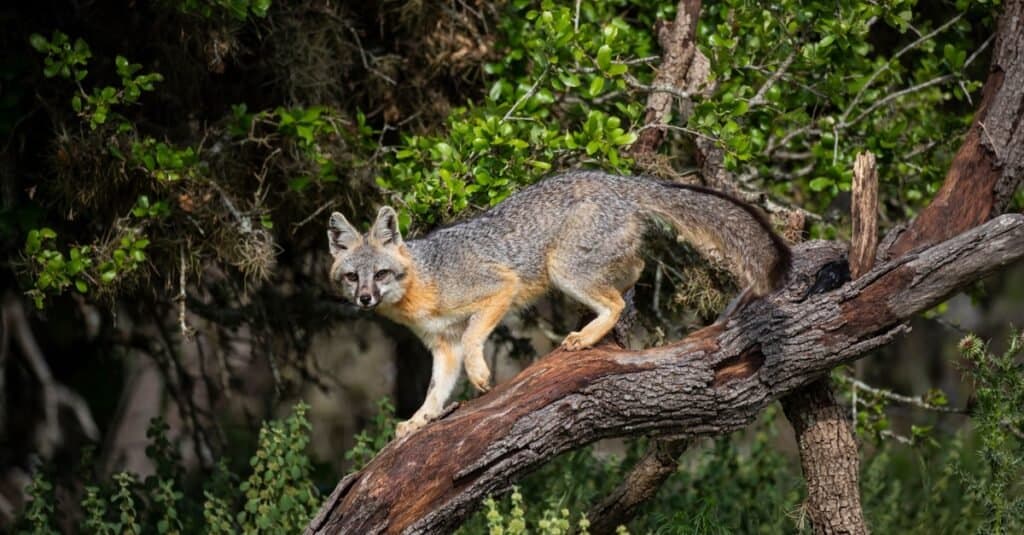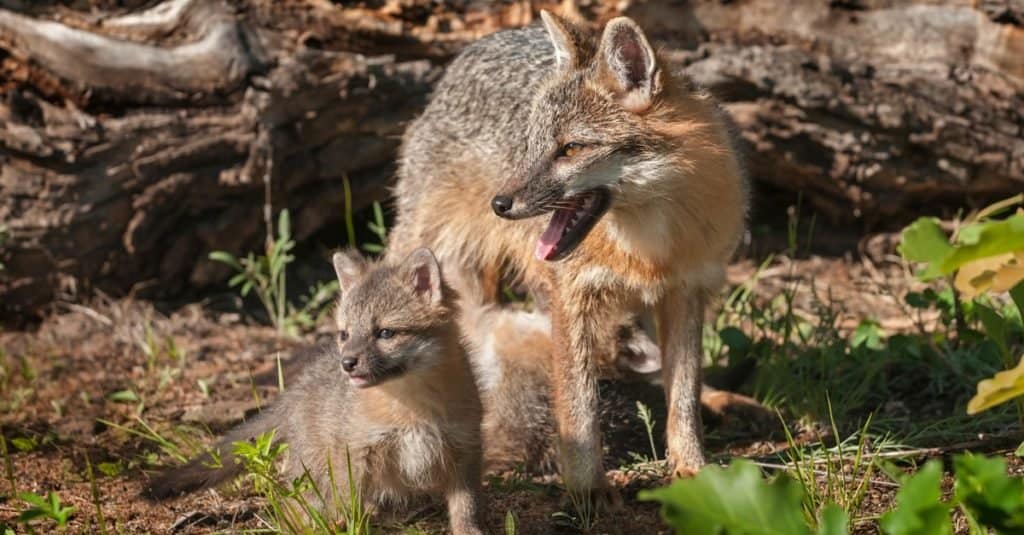The gray fox used to be the most common species of fox in the eastern region of the United States. Nowadays, even if it is spread throughout Central and North America, the species isn’t as common as red foxes. However, you can still have an impromptu meeting with this ashen silver creature in southern Florida’s urban and suburban areas, for example.
Given how the species adapted to living in urban and suburban areas, it’s curious what gray foxes eat and if their diet includes more natural prey or scavenged prey. If this is on your mind as well, keep on reading as we’ve prepared this article, especially for you!
What Are Gray Foxes?

Gray foxes are mammals in the
Canidaefamily.
©iStock.com/johnpane
Urocyon cinereoargenteus, commonly known as the gray fox, is a mammal in the Canidae family. It is native to Central and North America, but can also be found in northern South America. As the species name implies, its distinctive characteristics are the grizzled upper body parts.
Gray foxes are about 30 to 45 inches long, including the 11 to 17 inches long tail. In terms of weight, the average specimen can be about 8 to 15.4 lbs – females are slightly smaller than males, so they might weigh less.
What Do Gray Foxes Eat?

Gray foxes eat eastern cottontail rabbits, shrews, birds, voles, rodents, brush rabbits, and jackrabbits.
©Danita Delimont/Shutterstock.com
Gray foxes have an omnivorous diet. They primarily eat eastern cottontail rabbits, shrews, birds, voles, rodents, brush rabbits, and jackrabbits, as well as insects and herbs. Their diet is so diverse because it differs depending on where the animal lives.
As such, gray foxes in the eastern part of the US prefer mainly eastern cottontail rabbits – these comprise most of their diet, besides birds and shrews. In California, however, gray foxes’ diet consists mainly of rodents, followed by several rabbit species. Lastly, in the western part of the US, gray foxes have a diet consisting primarily of insects and plants.
Gray foxes are known to often introduce fruit into their diet, with no specific preferences. This happens between winter and spring. During that time, gray foxes make do with invertebrates, followed by grains and nuts.
It is also worth mentioning that gray foxes really enjoy grapes and persimmons. According to statistics and observation, these two fruits are eaten more often by this fox species than any other species.
How Can Gray Foxes Be Described?
Such a varied diet is bound to come with many characteristic terms. Gray foxes can be generally described as:
- Omnivores, carnivores, frugivores, granivores, herbivores, insectivores, and even scavengers. These terms refer solely to their diet;
- Nocturnal and crepuscular. These refer to the times of activity and hunting of gray foxes;
- Arboreal – indeed, gray foxes are known to be able to climb trees and move freely in them.
A List of Foods Gray Foxes Eat
Since they are omnivorous, gray foxes have an extremely diverse diet. They enjoy most of what we enjoy as well:
- Blackberries
- Persimmons
- Acorns
- Crickets
- Grasshoppers
- Corn
- Nuts
- Squirrels
- Rats
- Rabbits
- Voles
- Mice
- Birds
- Grains
- Grapes
What Eats Gray Foxes?

Golden eagles are among the predators of gray foxes.
©Martin Mecnarowski/Shutterstock.com
Even though reclusive and nocturnal (meaning quite hidden from sight), gray foxes do have some natural predators. Some of these are the golden eagle, cougar, bobcat, great horned owl, coyote, and hawk.
It is known that coyotes (and feral dogs) will not stand a gray fox in their territory.
Generally, adult gray foxes are considered to have a small number of predators. Most species mentioned above don’t hunt at the same time as gray foxes. Another major advantage of gray foxes is that they can easily climb up into a tree and escape some of their most vicious predators.
How Do Gray Foxes Hunt?

Gray foxes start hunting during the night.
©Holly Kuchera/Shutterstock.com
Gray foxes start hunting during the night. They hunt independently and never rely on other members of the same species (or other species). For living, moving prey, they engage mainly in clandestine following. They secretly follow the target and patiently await the right attack moment. When attacking, gray foxes prefer pouncing on the prey and biting its neck.
When it comes to the static part of their diet (plants), gray foxes engage in foraging behaviors. As some of their favorite plants are high up on the trees, this species of foxes have become excellent climbers.
An interesting aspect of the gray fox diet and its hunting behavior is that the species can adopt food-hoarding behaviors. If it hunts more than it can chew, the gray fox will dig a burrow and deposit the additional prey or food in it. Burrows are claimed and protected via a common territory marking method via urine marking.
Interesting Gray Fox Facts
- Gray foxes are the canids that share the most similarities with cats;
- Gray foxes are the only species in the Canidae family that can climb trees (they can even jump from one branch to another);
- Gray foxes give birth to about 1-7 pups (4 on average).
Up Next:
- Gray Fox in Texas: Where They Live and Interesting Facts
- Gray Fox vs. Coyote: Their Differences Explained
- Gray Fox vs Red Fox: What Are The Differences?
The photo featured at the top of this post is © Danita Delimont/Shutterstock.com
Sources
- Desert Museum, Available here: https://www.desertmuseum.org/kids/oz/long-fact-sheets/Gray%20Fox.php
- Big Bear Zoo, Available here: https://bigbearzoo.org/services/grey-fox/
- CT.gov, Available here: https://portal.ct.gov/DEEP/Wildlife/Fact-Sheets/Gray-Fox
- Animalia, Available here: https://animalia.bio/gray-fox
Thank you for reading! Have some feedback for us? Contact the AZ Animals editorial team.






